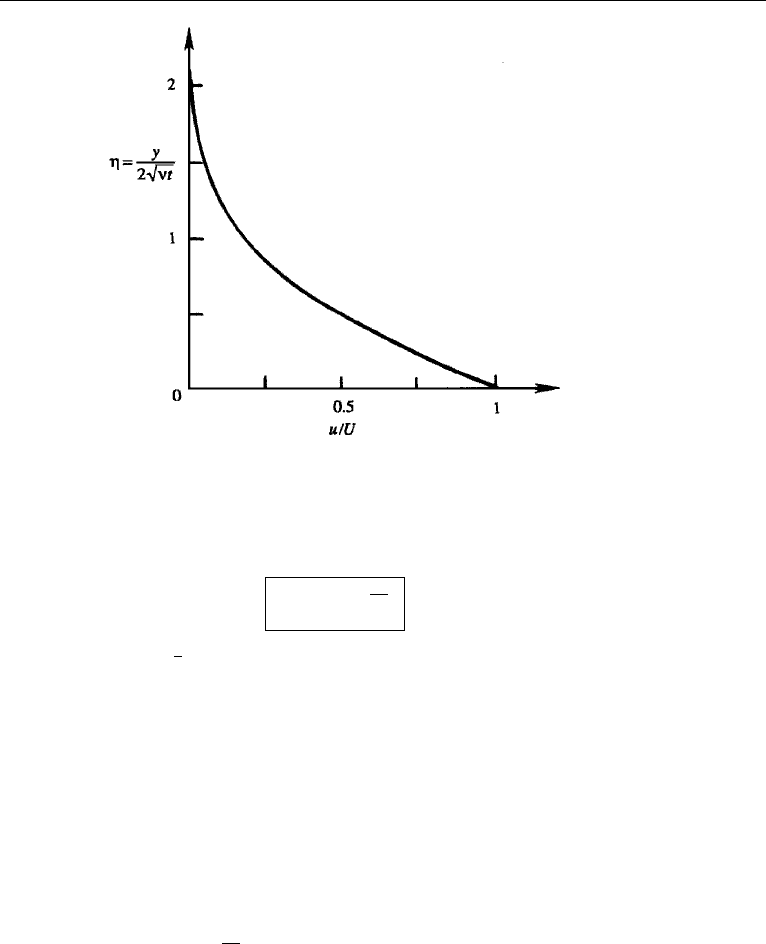Cohen I.M., Kundu P.K. Fluid Mechanics
Подождите немного. Документ загружается.


302 Laminar Flow
Figure 9.5 Laminar flow through a tube.
where we have introduced subscripts on τ and noted that the other stress components
are zero. As the left-hand side of the equation is zero, it follows that dp/dx must be
a constant and τ
xy
must be linear in y.
5. Steady Flow in a Pipe
Consider the fully developed laminar motion through a tube of radius a. Flow through
a tube is frequently called a circular Poiseuille flow. We employ cylindrical coordi-
nates (r,θ,x), with the x-axis coinciding with the axis of the pipe (Figure 9.5).
The only nonzero component of velocity is the axial velocity u(r) (omitting the
subscript “x”onu), and none of the flow variables depend on θ. The equations of
motion in cylindrical coordinates are given in Appendix B. The radial equation of
motion gives
0 =−
∂p
∂r
,
showing that p is a function of x alone. The x-momentum equation gives
0 =−
dp
dx
+
µ
r
d
dr
r
du
dr
.
As the first term can only be a function of x, and the second term can only be a
function of r, it follows that both terms must be constant. The pressure therefore falls
linearly along the length of pipe. Integrating twice, we obtain
u =
r
2
4µ
dp
dx
+ A ln r + B.
Because u must be bounded at r = 0, we must have A = 0. The wall condition u = 0
at r = a gives B =−(a
2
/4µ)(dp/dx). The velocity distribution therefore takes the
parabolic shape
u =
r
2
− a
2
4µ
dp
dx
. (9.10)

6. Steady Flow between Concentric Cylinders 303
From Appendix B, the shear stress at any point is
τ
xr
= µ
∂u
r
∂x
+
∂u
∂r
.
In the present case the radial velocity u
r
is zero. Dropping the subscript on τ ,we
obtain
τ = µ
du
dr
=
r
2
dp
dx
, (9.11)
which shows that the stress distribution is linear, having a maximum value at the
wall of
τ
0
=
a
2
dp
dx
. (9.12)
As in the previous section, equation (9.12) is also valid for turbulent flows.
The volume rate of flow is
Q =
a
0
u2 πr dr =−
πa
4
8µ
dp
dx
,
where the negative sign offsets the negative value of dp/dx. The average velocity
over the cross section is
V ≡
Q
πa
2
=−
a
2
8µ
dp
dx
.
6. Steady Flow between Concentric Cylinders
Another example in which the nonlinear advection terms drop out of the equations of
motion is the steady flow between two concentric, rotating cylinders. This is usually
called the circular Couette flow to distinguish it from the plane Couette flow in which
the walls are flat surfaces. Let the radius and angular velocity of the inner cylinder be
R
1
and
1
and those for the outer cylinder be R
2
and
2
(Figure 9.6). Using cylindrical
coordinates, the equations of motion in the radial and tangential directions are
−
u
2
θ
r
=−
1
ρ
dp
dr
,
0 = µ
d
dr
1
r
d
dr
(ru
θ
)
.
The r-momentum equation shows that the pressure increases radially outward due
to the centrifugal force. The pressure distribution can therefore be determined once
u
θ
(r)has been found. Integrating the θ-momentum equation twice, we obtain
u
θ
= Ar +
B
r
. (9.13)

304 Laminar Flow
Figure 9.6 Circular Couette flow.
Using the boundary conditions u
θ
=
1
R
1
at r = R
1
, and u
θ
=
2
R
2
at r = R
2
,
we obtain
A =
2
R
2
2
−
1
R
2
1
R
2
2
− R
2
1
,
B =
(
1
−
2
)R
2
1
R
2
2
R
2
2
− R
2
1
.
Substitution into equation (9.13) gives the velocity distribution
u
θ
=
1
1 −
(
R
1
/R
2
)
2
2
−
1
R
1
R
2
2
r +
R
2
1
r
(
1
−
2
)
. (9.14)
Two limiting cases of the velocity distribution are considered in the following.
Flow Outside a Cylinder Rotating in an Infinite Fluid
Consider a long circular cylinder of radius R rotating with angular velocity in an
infinite body of viscous fluid (Figure 9.7). The velocity distribution for the present
problem can be derived from equation (9.14) if we substitute
2
= 0, R
2
=∞,
1
= , and R
1
= R. This gives
u
θ
=
R
2
r
, (9.15)
which shows that the velocity distribution is that of an irrotational vortex for which the
tangential velocity is inversely proportional to r. As discussed in Chapter 5, Section 3,
this is the only example in which the viscous solution is completely irrotational. Shear
stresses do exist in this flow, but there is no net viscous force at a point. The shear
stress at any point is given by

6. Steady Flow between Concentric Cylinders 305
Figure 9.7 Rotation of a solid cylinder of radius R in an infinite body of viscous fluid. The shape of the
free surface is also indicated. The flow field is viscous but irrotational.
τ
rθ
= µ
r
∂
∂r
u
θ
r
+
1
r
∂u
r
∂θ
,
which, for the present case, reduces to
τ
rθ
=−
2µR
2
r
2
.
The forcing agent performs work on the fluid at the rate
2πRu
θ
τ
rθ
.
It is easy to show that this rate of work equals the integral of the viscous dissipation
over the flow field (Exercise 4).
Flow Inside a Rotating Cylinder
Consider the steady rotation of a cylindrical tank containing a viscous fluid. The
radius of the cylinder is R, and the angular velocity of rotation is (Figure 9.8). The
flow would reach a steady state after the initial transients have decayed. The steady
velocity distribution for this case can be found from equation (9.14) by substituting
1
= 0, R
1
= 0,
2
= , and R
2
= R.Weget
u
θ
= r, (9.16)

306 Laminar Flow
Figure 9.8 Steady rotation of a tank containing viscous fluid. The shape of the free surface is also
indicated.
which shows that the tangential velocity is directly proportional to the radius, so that
the fluid elements move as in a rigid solid. This flow was discussed in greater detail
in Chapter 5, Section 3.
7. Impulsively Started Plate: Similarity Solutions
So far, we have considered steady flows with parallel streamlines, both straight and
circular. The nonlinear terms dropped out and the velocity became a function of one
spatial coordinate only. In the transient counterparts of these problems in which the
flow is impulsively started from rest, the flow depends on a spatial coordinate and
time. For these problems, exact solutions still exist because the nonlinear advection
terms drop out again. One of these transient problems is given as Exercise 6. However,
instead of considering the transient phase of all the problems already treated in the
preceding sections, we shall consider several simpler and physically more revealing
unsteady flow problems in this and the next three sections. First, consider the flow
due to the impulsive motion of a flat plate parallel to itself, which is frequently called
Stokes’ first problem. (The problem is sometimes unfairly associated with the name of
Rayleigh, who used Stokes’ solution to predict the thickness of a developing boundary
layer on a semi-infinite plate.)
Formulation of a Problem in Similarity Variables
Consider an infinite flat plate along y = 0, surrounded by fluid (with constant ρ
and µ) for y>0. The plate is impulsively given a velocity U at t = 0 (Figure 9.9).
Since the resulting flow is invariant in the x direction, the continuity equation
∂u/∂x + ∂v/∂y = 0 requires ∂v/∂y = 0. It follows that v = 0 everywhere because

7. Impulsively Started Plate: Similarity Solutions 307
Figure 9.9 Laminar flow due to an impulsively started flat plate.
it is zero at y = 0. If the pressures at x =±∞are maintained at the same level,
we can show that the pressure gradients are zero everywhere as follows. The x- and
y-momentum equations are
ρ
∂u
∂t
=−
∂p
∂x
+ µ
∂
2
u
∂y
2
,
0 =−
∂p
∂y
.
The y-momentum equation shows that p can only be a function of x and t. This can
be consistent with the x-momentum equation, in which the first and the last terms
can only be functions of y and t only if ∂p/∂x is independent of x. Maintenance
of identical pressures at x =±∞therefore requires that ∂p/∂x = 0. Alternatively,
this can be established by observing that for an infinite plate the problem must be
invariant under translation of coordinates by any finite constant in x.
The governing equation is therefore
∂u
∂t
= ν
∂
2
u
∂y
2
, (9.17)
subject to
u(y, 0) = 0 [initial condition], (9.18)
u(0,t) = U [surface condition], (9.19)
u(∞,t) = 0 [far field condition]. (9.20)

308 Laminar Flow
The problem is well posed, because equations (9.19) and (9.20) are conditions at two
values of y, and equation (9.18) is a condition at one value of t; this is consistent with
equation (9.17), which involves a first derivative in t and a second derivative in y.
The partial differential equation (9.17) can be transformed into an ordinary
differential equation from dimensional considerations alone. Its real reason is the
absence of scales for y and t as discussed on page 287. Let us write the solution as a
functional relation
u = φ(U, y, t,ν). (9.21)
An examination of the equation set (9.17)–(9.20) shows that the parameter U appears
only in the surface condition (9.19). This dependence on U can be eliminated from
the problem by regarding u/U as the dependent variable, for then the equation set
(9.17)–(9.20) can be written as
∂u
∂t
= ν
∂
2
u
∂y
2
,
u
(y, 0) = 0 ,
u
(0,t) = 1,
u
(∞,t) = 0,
where u
≡ u/U . The preceding set is independent of U and must have a solution of
the form
u
U
= f (y, t, ν). (9.22)
Because the left-hand side of equation (9.22) is dimensionless, the right-hand side
can only be a dimensionless function of y,t, and ν. The only nondimensional variable
formed from y,t, and ν is y/
√
νt, so that equation (9.22) must be of the form
u
U
= F
y
√
νt
. (9.23)
Any function of y/
√
vt would be dimensionless and could be used as the new inde-
pendent variable. Why have we chosen to write it this way rather than νt/y
2
or some
other equivalent form? We have done so because we want to solve for a velocity profile
as a function of distance from the plate. By thinking of the solution to this problem in
this way, our new dimensionless similarity variable will feature y in the numerator to
the first power. We could have obtained equation (9.23) by applying Buckingham’s pi
theorem discussed in Chapter 8, Section 4. There are four variables in equation (9.22),
and two basic dimensions are involved, namely, length and time. Two dimensionless
variables can therefore be formed, and they are shown in equation (9.23).
We write equation (9.23) in the form
u
U
= F(η), (9.24)

7. Impulsively Started Plate: Similarity Solutions 309
where η is the nondimensional distance given by
η ≡
y
2
√
νt
. (9.25)
We see that the absence of scales for length and time resulted in a reduction of the
dimensionality of the space required for the solution (from 2 to 1). The factor of
2 has been introduced in the definition of η for eventual algebraic simplification.
The equation set (9.17)–(9.20) can now be written in terms of η and F(η). From
equations (9.24) and (9.25), we obtain
∂u
∂t
= U
∂F
∂t
= UF
∂η
∂t
=−UF
y
4
√
νt
3/2
=−
UF
η
2t
,
∂u
∂y
= U
∂F
∂y
= UF
∂η
∂y
= UF
1
2
√
νt
,
∂
2
u
∂y
2
=
U
2
√
νt
F
∂η
∂y
=
U
4νt
F
.
Here, a prime on F denotes derivative with respect to η. With these substitutions,
equation (9.17) reduces to the ordinary differential equation
−2ηF
= F
. (9.26)
The boundary conditions (9.18)–(9.20) reduce to
F(∞) = 0, (9.27)
F(0) = 1. (9.28)
Note that both (9.18) and (9.20) reduce to the same condition F(∞) = 0 . This is
expected because the original equation (9.17) was a partial differential equation and
needed two conditions in y and one condition in t. In contrast, (9.26) is a second-order
ordinary differential equation and needs only two boundary conditions.
Similarity Solution
Equation (9.26) can be integrated as follows:
dF
F
=−2ηdη.
Integrating once, we obtain
ln F
=−η
2
+ const.
which can be written as
dF
dη
= Ae
−η
2
,

310 Laminar Flow
where A is a constant of integration. Integrating again,
F(η) = A
η
0
e
−η
2
dη + B. (9.29)
Condition (9.28) gives
F(0) = 1 = A
0
0
e
−η
2
dη + B,
from which B = 1. Condition (9.27) gives
F(∞) = 0 = A
∞
0
e
−η
2
dη + 1 =
A
√
π
2
+ 1,
(where we have used the result of a standard definite integral), from which
A =−2/
√
π. Solution (9.29) then becomes
F = 1 −
2
√
π
η
0
e
−η
2
dη. (9.30)
The function
erf(η) ≡
2
√
π
η
0
e
−η
2
dη,
is called the “error function” and is tabulated in mathematical handbooks. Solution
(9.30) can then be written as
u
U
= 1 − erf
y
2
√
νt
. (9.31)
It is apparent that the solutions at different times all collapse into a single curve of
u/U vs η, shown in Figure 9.10.
The nature of the variation of u/U with y for various values of t is sketched in
Figure 9.9. The solution clearly has a diffusive nature. At t = 0, a vortex sheet (that
is, a velocity discontinuity) is created at the plate surface. The initial vorticity is in the
form of a delta function, which is infinite at the plate surface and zero elsewhere. It can
be shown that the integral
∞
0
ωdy is independent of time (see the following section
for a demonstration), so that no new vorticity is generated after the initial time. The
initial vorticity is simply diffused outward, resulting in an increase in the width of
flow. The situation is analogous to a heat conduction problem in a semi-infinite solid
extending from y = 0toy =∞. Initially, the solid has a uniform temperature, and at
t = 0 the face y = 0 is suddenly brought to a different temperature. The temperature
distribution for this problem is given by an equation similar to equation (9.31).
We may arbitrarily define the thickness of the diffusive layer as the distance at
which u falls to 5% of U. From Figure 9.10, u/U = 0.05 corresponds to η = 1.38.

7. Impulsively Started Plate: Similarity Solutions 311
Figure 9.10 Similarity solution of laminar flow due to an impulsively started flat plate.
Therefore, in time t the diffusive effects propagate to a distance of order
δ ∼ 2.76
√
νt (9.32)
which increases as
√
t. Obviously, the factor of 2.76 in the preceding is somewhat
arbitrary and can be changed by choosing a different ratio of u/U as the definition
for the edge of the diffusive layer.
The present problem illustrates an important class of fluid mechanical problems
that have similarity solutions. Because of the absence of suitable scales to render
the independent variables dimensionless, the only possibility was a combination of
variables that resulted in a reduction of independent variables (dimensionality of the
space) required to describe the problem. In this case the reduction was from two (y, t)
to one (η) so that the formulation reduced from a partial differential equation in y, t
to an ordinary differential equation in η.
The solutions at different times are self-similar in the sense that they all collapse
into a single curve if the velocity is scaled by U and y is scaled by the thickness of the
layer taken to be δ(t) = 2
√
νt. Similarity solutions exist in situations in which there
is no natural scale in the direction of similarity. In the present problem, solutions at
different t and y are similar because no length or time scales are imposed through
the boundary conditions. Similarity would be violated if, for example, the boundary
conditions are changed after a certain time t
1
, which introduces a time scale into the
problem. Likewise, if the flow was bounded above by a parallel plate at y = b, there
could be no similarity solution.
